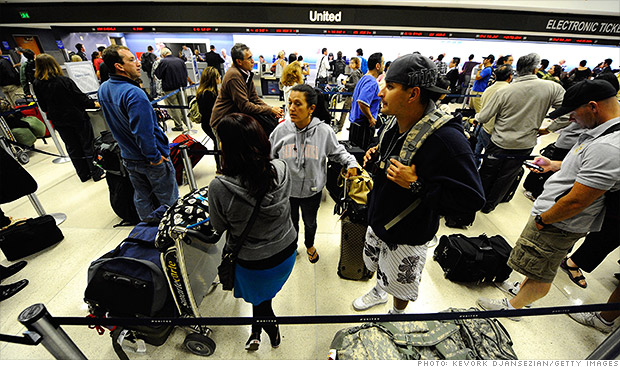
The March 1 budget cuts will affect Americans in myriad ways, like at airport check-in lines.
NEW YORK (CNNMoney)
The cuts are bad policy.
They're indiscriminate: They give spending cuts a bad name. The law governing them requires that they be applied in a uniform way across the board.
In other words, the meat of the federal government will be cut along with the fat, and by the same percentages in many instances. So needed projects and investments will be cut in equal measure with bloated projects that are duplicative. And people doing good work will lose jobs or pay right alongside people who do shoddy work.
"There's no business in the country that makes its cuts across the board. You ... try to surgically cut those things that have the least adverse effect on productivity," Erskine Bowles, who co-chaired President Obama's fiscal commission, said at a Politico breakfast this week.
(Related: Jobless benefits would be hit)
They cut from the smallest part of the budget: Most of the cuts will come from discretionary spending -- defense and nondefense -- which together account for just over a third of all spending.
What's more, discretionary spending has already been subject to spending curbs. So much so that even without the March 1 cuts, discretionary spending is on track to fall to a 50-year low as a share of the economy by the end of the decade.
That doesn't mean more can't be cut from discretionary, but the magnitude, the manner and the timing of the March 1 cuts are ill-advised.
They don't really address the debt: The irony is that while the spending cuts will reduce deficits, they won't do anything to keep the country's debt from growing at an unsustainable rate.
That's because the real drivers of the country's debt -- in particular the entitlement programs Medicare and Social Security -- are largely exempt from the March 1 cuts.
The big entitlements take up the largest single part of the budget now -- about 43% of all spending -- and will swallow up ever larger chunks over the next few decades because of the aging of the population and the still-fast-growing cost of health care.
Indeed, spending on entitlements and interest on the debt, barring any changes, will grow faster than the economy indefinitely.
"They keep slashing the one-third of the budget that has already been seriously squeezed by the [2011 Budget Control Act's] spending caps, while not taking any significant actions on entitlement spending or tax expenditures," said budget expert Charles Konigsberg.
So given all the strikes against it, why is the so-called sequester still in place? Because lawmakers can't get it together to replace it with something better.
They might get around to it by the end of March -- or March 27 to be precise. That's when the current government funding bill, known as a continuing resolution, expires. If Congress doesn't pass a new one, the government will shut down on March 28.
That's a rather unattractive prospect for both parties.
So it's possible the threat of a government shutdown, coupled with public anger over the cuts -- which will affect Americans in myriad ways -- might just compel lawmakers to undo at least some of the March 1 budget cuts before they do too much damage. ![]()
First Published: February 21, 2013: 9:45 AM ET
Anda sedang membaca artikel tentang
Biggest problems with the budget cuts
Dengan url
http://kasiatbuatsehat.blogspot.com/2013/02/biggest-problems-with-budget-cuts.html
Anda boleh menyebar luaskannya atau mengcopy paste-nya
Biggest problems with the budget cuts
namun jangan lupa untuk meletakkan link
Biggest problems with the budget cuts
sebagai sumbernya


0 komentar:
Posting Komentar